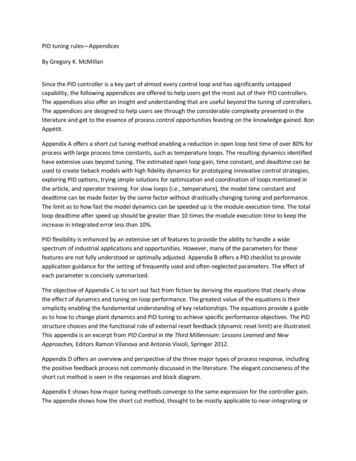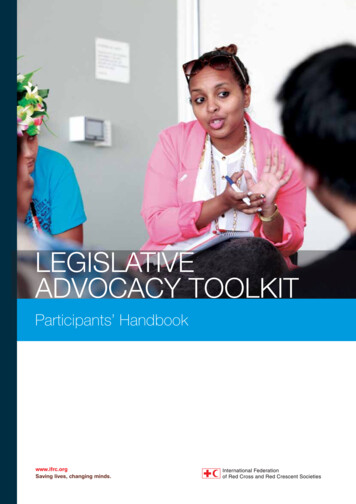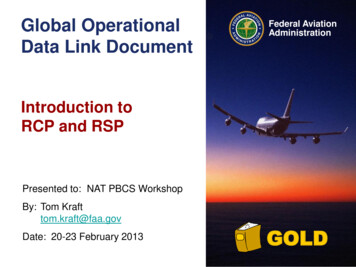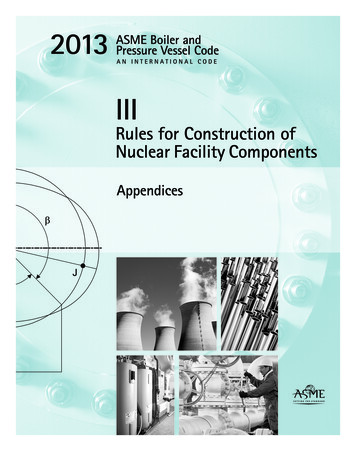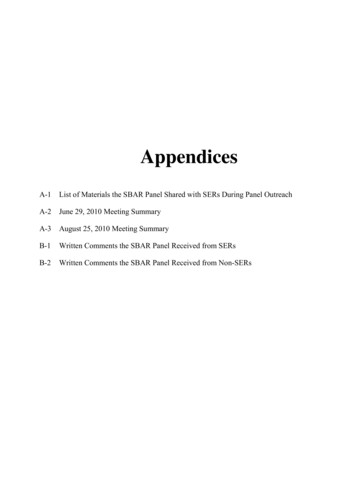
Transcription
AppendicesA-1List of Materials the SBAR Panel Shared with SERs During Panel OutreachA-2June 29, 2010 Meeting SummaryA-3August 25, 2010 Meeting SummaryB-1Written Comments the SBAR Panel Received from SERsB-2Written Comments the SBAR Panel Received from Non-SERs
APPENDIX A-1List of Materials the SBAR Panel Shared with SERs During Panel Outreach
Materials for EPA’s Outreach Meeting with Small Entity RepresentativesTuesday, June 29, 20101. PowerPoint Presentation - "Revision of Subpart AAA Residential Wood Heaters & Additional NewSource Performance Standards (NSPS)"2. Fact Sheet for Potential Small Entity Representatives - Revision of New Source Performance Standardsfor Wood Stoves, other Residential Solid Biomass Combustion Devices, and Coal Stoves Under Section111(b)(1)(B) of the Clean Air Act3. List of Potential Small Entity RepresentativesMaterials for EPA’s Outreach Meeting with Small Entity RepresentativesWednesday, August 25, 20101. Invitation letter from Alex Cristofaro, Chair of the Small Business Advocacy Review Panel (SBAR), toSERs.2. PowerPoint Presentation - Revision of Subpart AAA Residential Wood Heaters & Additional New SourcePerformance Standards (NSPS)3. Questions for Small Entity Representatives - Revision of New Source Performance Standards for NewResidential Wood Heaters and Additional NSPS(s) for Other Residential Solid Biomass CombustionDevices4. List of Small Entity Representatives
Appendix A-2June 29, 2010 Meeting Summary
EPA’s Outreach Meeting withPotential Small Entity Representatives (SERs)Revision of New Source Performance Standards for New Residential Wood HeatersTuesday, June 29, 2010EPA Headquarters, Washington, D.C.AttendeesFederal Agency representativesAlexander Cristofaro, EPACaryn Muellerleile, EPACortney Higgins, OMBDavid Cole, EPAGil Wood, EPAJan King, EPAJohn Dupree, EPAJoe Johnson, SBAKeith Holman, SBAKen Munis, EPALucinda Power, EPAScott Jordan, EPAPotential SERsBen Myren, Myren ConsultingBrian Klipfel, Fireworks MasonryBryan Light, BIACharles Clark, BIAChris Neufeld, Blaze King IndustriesClay Dennis, Zephyr Stoves Inc.Dean Lehmann, Hitzer Coal StovesEric Moshier, Solid Rock Masonry Inc.Frank Moore, Hardy ManufacturingJames Frisch, Western MasonryJim Buckley, Buckley Rumford Co.Joe Anderson, Knoxville Stove WorksJohn Crouch, HPBAJohn Klopstad for Jim Hussong, Kozy HeatJohn Russo, Bluestone Boiler CorporationMike Haefner, American Energy SystemsMitch Pisik, Breckwell Hearth ProductsPaul S. Anderson, Chip Energy Inc.Paul Williams, U.S. Stove CompanyRobert Huta, RLH Industries Inc.Ron Pihl, WarmstoneScott Jacobs, Ozark Hardwood ProductsScott Nichols, Bioheat USATimothy Seaton, Timely ConstructionOther AttendeesAl Breckel, Breckwell Hearth ProductsClaren Lehmann, Hitzer Coal Stoves.Nicholas Bian, HPBASeth Voyles, HPBASER discussion points Potential SER comment: Is EPA going to require that all testing labs and pellet stove manufacturers usethe same quality pellet for emissions testing of stoves? This is important since most stove manufacturesare testing with a very low ash ( 0.5% ash) pellet so they can pass PM2.5 testing. If EPA requires testingof a super premium pellet, it will exclude a number of pellet manufacturers.o EPA response: The decision is between the appliance manufacturers and the pellet manufacturers asto the appropriate quality of pellet. EPA is not encouraging any particular grade of pellet. Once theappliance manufacturers have made the decision, then it should be tested. EPA requested additionaltest data on different grades of pellets. Potential SER comment: Most of our industry (family-owned businesses) isn’t aware of the proposedregulations. For example, most masons don’t understand test methods (e.g., difference between methods
5G and 5H, how to measure emissions per burn rate, etc.) EPA needs to take more time to understand theindustry and how masonry fireplaces are built. Including fireplaces in the NSPS regulations at this time isnot a good idea. It would put several hundred thousand people out of work and destroy an entire segmentof the masonry industry without, we think, much noticeable benefit.o EPA response: Masons will not need to know the difference between Test Methods 5G and 5H.Ideally, there will be a few designs that any mason can use that will have been shown to meet theemission limits. There are a number of State and local agencies and environmental groups who wantEPA to regulate fireplaces (both manufactured and masonry) because of the emissions concern. Thereare ways to regulate fireplaces that won’t put small entities out of business. Potential SER comment: Which units will be grandfathered-in in the new NSPS? Will any currently-listedproducts that meet or burn cleaner than the new standards be grandfathered-in?o EPA response: EPA is not planning to regulate existing devices in this NSPS, but we are expandingthe scope of the current standard to regulate other new devices that are not currently included. Allnew units regulated by the NSPS will be required to comply with the NSPS. However, EPA continuesto support change-outs of existing devices to appliances that will burn cleaner. Potential SER comment: What is EPA’s thinking about testing pellet stoves at different burn rates? It’scommon for the consumer to set the burn rate at a “3” or “4”. A weighted average burn rate is okay as long asthe manufacturer isn’t required to do unnecessary testing and that efficient models designed at low burn ratesare not knocked out of the market.o EPA response: The intent of testing at low burn rates is to include the performance of the stoves atthe low burn rates that homeowners use. If the device is designed so the homeowner cannot operate itat the typically lower-efficiency, higher-emission low burn rate, then that is good for the homeownerand the environment, and that will be incorporated into the test methods (e.g., heat storage). Moreinformation is needed on this question, and EPA will follow up with the potential SER. Potential SER comment: Is EPA going to establish a certain number of designs for site-built masonryfireplaces that would be put into the building code?o EPA response: Industry would be responsible for developing the designs. We are consideringdevelopment of a two-prong approach for masonry heaters and fireplaces that allows wide-spreaduse of generic designs and are shown to meet the emission limits in lieu of testing each new modelline. Potential SER comment: It would be a profound change and very disruptive for a mason following abuilding code to design and test a system. Within a short time, will all those masonry fireplaces have to bebuilt according to a certain design? Who’s going to come up with the design? Or the testing parameters tocome up with the design?o EPA response: We hope that the industry will work together to develop a few good designs that allmasons can opt to use. Ideally, these designs would be incorporated into the building code so themasons can follow the code like they are used to doing all the time. The parameters for testing arealready established in the ASTM test method. Potential SER comment: Will these fireplaces have to be accredited by ISO?
o EPA response: We are patterning the NSPS from the voluntary fireplace program. The testing of thedesign will be done by an ISO-accredited lab, and an ISO-accredited certifying body will review thetest and the quality control plan and do some inspections to determine that the units are consistentwith the design. This information would be given to EPA, and then the device would get an EPAlabel. Potential SER comment: One of the potential SERs indicated that he participated in some of the “fireplace”discussions, but the discussions were focused on manufactured units, not site-built units. For the most part,fireplace masons were not part of those discussions. According to the potential SER, the masons have notbeen involved in discussions about testing representative models. It would take a lot of effort for the averagefireplace mason to get on board with that concept.o EPA response: Although the discussions focused on manufactured units, there also were discussionsthat led to the agreement to use the ISO-accredited certifying body to review the quality control planand inspect an appropriate number of site-built fireplaces. Potential SER comment: EPA should have a separate meeting with the Mason Contractors Association ofAmerica (MCAA) to voice opinions on masonry fireplaces.o EPA response: We agree that a separate discussion with fireplace masons is appropriate. Potential SER comment: We agree that the expansion of the NSPS merits a move to an electronic system forsubmitting and reviewing compliance test reports. A change like this involves some expenditures willOECA have the resources to go to an electronic system?o EPA response: We definitely want to move toward an electronic system, but the Office ofEnvironmental Information has some concerns about the system; other rules with electronicsubmissions would need to be considered as well. Potential SER comment: Would EPA have the workforce to do third-party certification testing for pellet fuelquality?o EPA response: There would be a resource concern if EPA were to do this. We are very hopeful thatthe Pellet Fuels Institute will take this on. Potential SER Comment: It is good to see that Slide 27 notes that the current NSPS gave additional time forinitial compliance for small-volume manufacturers and that EPA expects to do that again. Many companieswill need more time.o EPA response: There is a difference between small entity and small volume. In the NSPS, it is smallvolume. Potential SER comment: [Commenting on Slide 29, “Example Wood Stove Example Options,” by 2014, allwood stoves (catalytic and non-catalytic stoves) comply with a 3 grams per hour limit] Although this exampleoption (one number) would encourage the development of new technologies, there’s a financial concern aboutthe R&D costs to manufacturers of constantly testing new products to comply with lower emission numbers.o EPA response: EPA will look into that.
Potential SER comment: What cost benefit is there to continue lowering the emission limits for pelletstoves?o EPA response: The health benefits provide a strong motive for reducing particulate matter emissions. Potential SER comment: We are concerned with the costs of testing masonry heaters and fireplaces. Onepotential SER has a lot of third-party test data, but every one of his masonry heaters is disqualified based onEPA’s example option for 2014 compliance, i.e., the combination of the 2 g/hr daily average number with the7.5 g/hr cap during the actual burn time. As a follow up, masonry heater test data will be sent to EPA. Potential SER comment: Do coal stoves show up in the national inventory? Coal is such a small part of thetotal inventory. Is it worth spending the time [developing a regulation] on it?o EPA response: No, they do not show up in the inventory, though we’ve received a number ofrequests for coal stoves to be included in the revised rule. We are trying to level the playing field forall appliances. [Note: EPA subsequently found emission inventory data for coal stoves and sent it tothe SERs.] Potential SER comment: [Referring to Slide 38, questioning the “high cost-effectiveness” [sic] number].The number 500K per ton of PM2.5 emissions reduced – that would cut across different industries. What isthe likelihood of that happening and the impact of yearly sales on new appliances?o EPA response: That number is based on the benefits, not the compliance costs. We are still workingon the costs and economic impacts. Once the SBAR Panel convenes, hopefully we will have a betterunderstanding of what the costs are and how it will impact small businesses. EPA needs more data.For example, we don’t have good data for number of manufacturers and how many are small entities.We will appreciate what information the SERs can provide. Potential SER comment: There was a request for the sources of the information found on Slide 38 of theslide presentation (benefits of PM 2.5 reductions in general and for wood stove change-outs), as one potentialSER feels the numbers are too high.o EPA response: We will provide that information. Question from EPA to Potential SERs: EPA needs more data from the industry. For example, how manymanufacturers are there? How many are small businesses and members of HPBA? Please send us whateveremissions and efficiency data you have. How much are you currently spending on R&D, production,marketing and warranty claims? What is the price elasticity for various devices? What are the marketdrivers? We need data on return on investment and product substitution. These are the areas of data thatwould be very helpful to EPA in developing this rule. Potential SER comment: [Referring to Slide 4—13 percent of the 2008 national emissions inventory is fromresidential wood combustion] Where is the other 87 percent coming from. What kind of regulatory pressureis being put on these other industries? He would like to see the percent emissions contribution for the otherindustries.o EPA response: A lot of the other emissions are from mobile sources and large industries that EPAand the States have regulated for years. EPA will provide data on the other sources in the inventory.
Potential SER comment: Are there numbers on yearly sales of appliances? EPA response: We will provide that information. Again, we are interested in information that theSERs may have that will help inform our analyses Potential SER comment: How are venting manufacturers going to be affected by this rule (flexible chimneyliners, Class A chimney manufacturers, etc)? We are being pounded by the economic downturn. Has EPAdone a statistical analysis of how this rule will affect small venting manufacturers?o EPA response: We don’t have enough information yet to determine what the impacts of the rule willbe on venting and chimney manufacturers. We need information on price elasticity. Please providethis if you have it. Potential SER comment: Will efficiency testing for wood and pellet stoves be required?o EPA response: Yes. Potential SER comment: We want retailers to be part of the panel. Do you still plan to include them?o EPA response: The current standard and the voluntary program include permanent labels andhangtags, owner’s manuals, etc. We need to know from retailers how best to do that for all of theappliances already included and the additional types of appliances that will be added. Potential SER comment: Is EPA looking into pellet stove efficiency standards?o EPA response: We are not sure if we will set a standard versus just requiring reporting of the testresults. We don’t have as much efficiency information for pellet stoves as we would like to have.
Appendix A-3August 25, 2010 Meeting Summary
EPA’s Outreach Meeting withSmall Entity RepresentativesRevision of New Source Performance Standards for New Residential Wood HeatersWednesday, August 25, 2010EPA Headquarters, Washington, D.C.Attendees:Federal Agency Representatives:Alex Cristofaro, EPALanelle Wiggins, EPALucinda Power, EPAGrant MacIntyre, EPAJoan Rogers, EPALester Facey, EPAJohn Dupree, EPAScott Jordan, EPAGil Wood, EPADavid Cole, EPAJan King, EPAKevin Bromberg, SBACortney Higgins, OMBBeth Friedman, EC/R (EPA Contractor)SERs and Other Small Entities:John Crouch, Hearth, Patio and Barbecue Association (HPBA)Chris Neufeld, Blaze King IndustriesRichard Thomas, Courtland HearthTimothy Seaton, Timely ConstructionDean Lehman, Hitzer Inc.Duane Miller, Kitchen Queen LLCAaron Stoll, Pioneer StovesDon Serrena, National Association of Home BuildersCalvin Haggard, US Stove Co.August S.L. Jones, US Stove Co.Paul Williams, US Stove Co.Frank Moore, Hardy ManufacturingCharles Clark, BIAAllan Cagnoli, HPBAPeter Wyckoff, Pillsbury WinthropNicholas Bian, HPBALeslie Wheeler, HPBAScott Jacobs, Ozark Hardwood ProductsBen Myren, Myren ConsultingScott Nichols, Bioheat USAMitch Pisik, Breckwell Hearth Products
Clay Dennis, Zephyr Stoves Inc.Eric Moshier, Solid Rock Masonry Inc.Mike Haefner, American Energy Systems Inc.Jim Buckley, Buckley Rumford Co.Brian Klipfel, Fireworks MasonryAl Breckel, Breckwell Hearth ProductsJohn Russo, Bluestone Boiler CorporationAlex Christofaro, EPA Small Business Chair, opened the outreach meeting and provided a brief background onthe Regulatory Flexibility Act. He added that previous discussions and discussions held today will help informthe SBREFA panel on recommendations for the proposal. He reminded all participants that written comments aredue to the Panel by September 12, 2010. The Panel will then prepare a report to document specificrecommendations for the Administrator to consider with respect to regulatory flexibility options for smallbusinesses. The report will include all of the written comments from the SERs, and it will be placed in therulemaking docket and made available to the public at the same time the rules are proposed.EPA OAQPS presented briefly the main points of the rule, including a recap of proposals under consideration, asdiscussed at the June 29, 2010 outreach meeting. Since this last meeting with SERs, EPA OAQPS has met inperson or by phone with a number of SERs to better understand their concerns and to obtain cost and emissionsdata—Masonry Heater Association, Mason Contractors Association of America, Brick Industry Association, andhydronic heater industry representatives. EPA emphasized the need for SERs to provide more of these data tosupport development of regulatory options and the economic impacts analysis. After EPA’s introductory remarks,the SERs requested time during the meeting to formally present comments and concerns to help frame some ofthe questions EPA has asked the SERs to respond to. Their comments and concerns are described below.GeneralSERs are concerned that the proposed rule will require a massive effort given the number of subcategories EPAanticipates regulating, and that some of these appliance types have never been tested. One SER stated that ideallysome of these questions that were posed to the SERs would already have been answered by EPA’s Office ofResearch and Development if they had been able to continue funding research at the levels they did in the early1990’s.SERs Representing Fireplace Manufacturers (including “Builders”)SERs strongly believe that more time is needed to develop standards for site-built fireplaces given the highvariability of these appliances and the voluntary program EPA has in place.Fireplaces will need their own “significance” listing.One SER estimated that, based on information from manufacturers of fireplace dampers, about 35,000 site-built(masonry) fireplaces were built in 2009. In a good market, that number is closer to 50,000 units. The SERestimated there are about 140,000 masons in the U.S., but the industry does not know how many are residentialversus commercial. The masons became involved in discussions on the NSPS revision “late in the game”;therefore, this industry needs more time to react to EPA’s suggestion of a certification program for masons,testing protocols, etc. The SER expressed concern that site-built fireplaces do not lend themselves to a singlecookie-cutter design; consequently developing multiple “clean” designs would be very difficult.SERs Representing Wood Stove ManufacturersOne SER stated that some consumers may not purchase new wood stoves if they are dramatically more expensivethan their existing ones. Another SER indicated that the NSPS revision will have a significant impact on his
company, as they manufacture not only wood stoves, but six other wood heater categories (e.g., pellet stoves,corn stoves, warm air furnaces, coal stoves, cook stoves, etc.).SER Representing Indoor Wood Furnace ManufacturersOne SER stated that the test protocol for warm-air [wood-burning] furnaces only began to be developed in April2010. Although his company and others he is representing are committed to the NSPS revision, they will needmore time to comply with the rule.SER Representing Wood, Pellet and Corn-burning Appliance ManufacturersThe SER representing wood, pellet and corn-burning appliance manufacturers first described an overview of hiscompany. The SER expressed concern about these appliances achieving an emission limit of 1 gram per hourusing pellet fuel with a high-ash content. The SER asked how EPA will test for appliances that burn multiplefuels—will an appliance be certified using the worst-grade fuel? Will manufacturers be required to list emissionsfor each individual fuel? The SER believes this will be a problem for them. According to the SER, pellet stovesrepresent less than 5 percent of the total residential wood heater market, and less than 1 to 2 percent of the marketfor multiple fuel-burning appliances. The SER estimated that the revised NSPS would increase the average costof a wood pellet stove by about 300- 500 per unit (based on industry-established volume of sales between 5-7million), a cost increase that the market is not likely to bear when sales are down. He also estimated it wouldtake about 12 years for manufacturers to recoup their expenses from developing and testing, and about 4½ yearsto develop a new product line that can comply with the test method. The SER is most concerned about theexpense of setting up a test lab (estimated cost 300,000) in such a short timeframe during a weak economy.SER Representing Wood Pellet Fuel ManufacturersThe SER representing wood pellet fuel manufacturers presented an overview of the pellet industry. He reportedthat the majority of pellet producers have fewer than 50 employees. In 2008, North American total wood pelletfuel capacity was 4.2 million metric tons. In 2009, capacity decreased to 2.6 million metric tons (including newplants). Over 80 percent of pellets are shipped to destinations within the U.S. The remainder goes to Europe, agrowing trend. The new, larger pellet start-ups are exporting about 90 percent of its production to Europeanmarkets.Pellet fuel is a growing market. The recent growth in pellet production is due to the rising cost of oil, climatechange and increased demand for biomass. According to the SER, the pellet industry is receiving the revisedNSPS well; however, there is a need for pellet standardization--super premium pellets with low ash content (lessthan 5 percent) is not generally available across the U.S. One SER is concerned that EPA’s current testing andcertification of pellet stoves is based on pellet fuel with a low-ash content from Douglas fir from the Northwest,which is not typical of pellet fuels in New England and other parts of the U.S. Best Demonstrated Technologyfor pellet stoves should not be based on pellet grades that do not represent most of the country.SERs Representing Hydronic Heater ManufacturersOutdoor Hydronic Heaters--The SER representing outdoor wood/pellet hydronic heater (HH) manufacturers(without thermal heat storage) indicated that although numerous HH models are already qualified to meet thelevel of the Phase 1 voluntary program (0.60 pounds per million Btu heat input) and the Phase 2 voluntaryprogram level (0.32 pounds per million BTU heat output), new units meeting the Phase 2 voluntary program levelwill cost about 10,000 to 11,000 per unit, about double the cost of the Phase 1-qualified units, and the costs forPhase 3 models will be even higher. The SER believes that potential consumers will view the newer HH units as“unaffordable” based on the consumer’s desire for a 4-year return on investment, and “definitely not affordable”if the return on investment takes 8 years, despite the overall net payback. The HH industry is developing (andwill submit to EPA) an approach to address the many differences between the European test method and theEPA-approved Method 28-OWHH. The SER is also concerned about the increased price of a unit (about 10
percent) if the revised NSPS requires heat storage. The SER also commented that EPA should be looking at realworld burn rates (based on cordwood) and not lab testing (based on cribs). The SER expressed concern that BDTfor these appliances would be too costly for the consumer.More comments from SER representing outdoor hydronic heaters: The manufacturers would like to see a hold at the current (voluntary Phase 2) emission qualifying level of0.32 lbs/mm btu heat output indefinitely for the following reasons. --Since the Phase 2 HH models with the 0.32 lbs/mm btu output limit are relatively new to themarketplace, there is no way to determine lifespan of these models.--Even small cuts to the already low limit make it exponentially tougher for manufacturers to develop,test, manufacture, and bring new appliances to market.--Adding more stringent limits will only add more restrictions to fuel used, maintenance required, andmore complicated electronics/sensors that will drive prices up and discourage potential customers.--The limit of 0.32 lbs/mm btu output is already a very low limit in comparison to other types ofappliances whose emissions are NOT based on output/efficiency. This is the first time that wood heatingappliances in the U.S. have had to meet an efficiency requirement. By comparison, indoor woodstoveshave never had to meet an efficiency requirement and it is unknown how decreasing the emissions limitfrom 7.5 g/hr to 4.5 g/hr as Washington did, effects efficiency. Therefore, there are really no otherproducts to base that information on.Currently, there are some programs available to provide consumer rebates, tax credits, and discounts topurchase appliances that use renewable energy for home heating.o The costs associated with engineering, testing and bringing to market new products to meet aspecific emissions limit (efficiency requirement) could have effects that reach beyond the costsassociated with manufacturers: In turn, the market may limit consumer choices regarding the numbers of appliancesavailable in the marketplace to a very few, It could limit the appliances capabilities to provide adequate heat by significantly reducingor completely replacing fossil fuels, rather than just providing supplemental heat, It has already been shown to drive prices up for these products (indoor woodstoves &outdoor wood furnaces, i.e., engineering, testing, materials, marketing, etc.), New technology makes appliances more difficult to operate – especially compared to the“conventional” technology, Prevent consumers from voluntarily changing out their older, more polluting and lessefficient appliances to renewable alternative energy sources.Indoor Hydronic Heaters--The SER representing indoor hydronic heaters (with thermal heat storage) madeseveral remarks about HH testing: (1) Timing: More time is needed to phase in the tighter emission level forindoor models. The SER believes EPA is favoring outdoor HH over indoor units in terms of the “grace period”(phase-in) given to the industry to meet the tighter emission level— 5-7 years for outdoor units versus 3 years forindoor units. The SER stated that the indoor HH industry wants the same opportunity as the outdoor industry inorder to solidify the indoor test method. More time is needed to test and set up a dilution tunnel for his indoor
models. There’s a problem not knowing in advance what indoor HH test methods would be available in 2012when EPA plans to issue the revised rule. (2) The SER indicated he was not part of the ASTM process for HH,and that Method 28-OWHH was designed for outdoor, not indoor, units. The SER stated that, unlike thedevelopment of the Outdoor HH test method, there has been no input from EPA, NESCAUM States or HPBA ondevelopment of an indoor HH test method. (3) There’s a need for a method to test HH indoor units with remotethermal storage.SER Representing Masonry Heater ManufacturersThe SER representing masonry heater manufacturers presented an overview of this industry sub-category, whichis dominated by one large manufacturer, selling 15,000 units per year worldwide and accounting for 60-70percent of sales. In a good year, the other masonry heater manufacturers might each sell 20 units. According tothe SER, only the top one or two largest producers are likely to remain in business as a result of the rule. TheSER questioned the feasibility of testing masonry heaters—representativeness of the crib method and the fact thatefficiency testing is based on another method. The SER is not aware of any masonry heater models that can meetthe levels beyond those required in Colorado and Washington State, especially a 7.5 g/hr cap during thecombustion period.SERs Representing Cook Stove ManufacturersOne SER recommended a tighter definition for cook stoves (intimating that cook stoves should not be subject tothe new NSPS). About 80 percent of cook stoves are marketed to the Amish, and the NSPS will have an impacton their way of life. Another SER indicated that the traditional North American cook stove is based on theAmish design; the definition of “cook stove” HPBA recommended to EPA is based on this design.SER Representing Coal-fired Heaters One SER indicated that, because the coal stove industry has a smaller footprint than wood and other biomasscombustion appliances, the industry does not have the capital necessary to develop a test method for coal-onlyappliances. The SER also commented that a challenge for this sub-category is the type and availability of fuelproduced in different parts of the U.S. For example, a coal stove designed for Pennsylvania anthracite coalwill not burn effectively in a coal stove that relies on bituminous coal produced from other parts of thecountry. On average, approximately 5000-6000 coal stoves are sold per year industry-wide, and about 23units per year from the SER’s coal stove company.SER Representing Third-party Testing LabsThe SER representing third-party testing labs exp
Appendices . A-1 List of Materi



